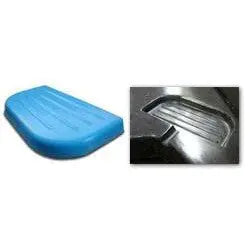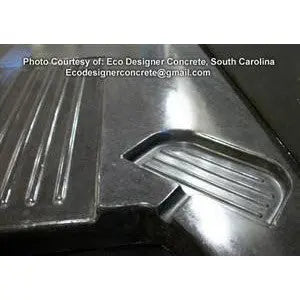



Concrete Mold, Soap Dish
Size:
Size
Quantity:
Fast Ship: Usually takes 1-2 business days to ship out.
Ships from Utah (Click for average Ground delivery map )
)
Ships from Utah (Click for average Ground delivery map
 )
)
Concrete Mold, Soap Dish
- Rubber Soap Dish insert for use with concrete countertop fabrication.
- Fast and simple to use. Add a professional soap dish to your countertop form in minutes.
- Reusable- Made of durable polyurethane that can flex and stay strong. Re-usable dozens or more times with proper care.
Specifications- Concrete Mold, Soap Dish:
- Available in two thicknesses:
- Standard size: 6" Wide, 3" long, 1/2" Thick
- Thin size: 6" Wide, 3" long, 1/4" Thick
- The three sides to the Soapdish Mold have a sloped angle to them, with the side that is designed to meet the sink being flat, so it can be placed right against the Sink Mold, or sink knockout piece.
- The Soapdish Mold 4 depressed grooves in the Mold, which create raised channels in the finished concrete.
- Grooves add a visual element to the Soapdish, and allow water to drain off the soap bar.
- Channels are approx. 3/16" wide.
- Three of the channels are 5" long, and one is 3 3/4" long.
Concrete Mold, Soap Dish Setup:
- Place Soapdish Mold in your form and silicone in place.
- For most applications (Precast), run a silicone a bead across the bottom edge of the mold to create a water-tight seal.
- If using for poured in place concrete countertops, press the mold down into the concrete surface, lightly tapping until flush with the surface, and then place with 2x4's across the top of the concrete and mold to hold it in place while the concrete sets up.
- Use of a Rubber Safe form release is recommended, but usually not necessary. Form release generally will create a smoother finish on the concrete, less air pockets, and make cleaning the rubber mold easier when finished.
- Vibrate concrete well (either vibrating the concrete, or rapidly tapping the edges of the forms with a hammer or palm sander), to remove as many air pocket voids as possible.
Mold Removal:
- After the concrete is sufficiently set up (typically 2-3 days for precast), flip the concrete piece over and remove the mold. In many cases, the mold will stay siliconed to the form when separated from the concrete.
- Concrete may have small 'bumps' which can be sanded off with a 200 grit sandpaper.
- Fill any air pocket voids with a Concrete Slurry Mix.
Rubber Mold Care:
- Clean with a stiff brush and water after each use. Any silicone left on the forms should be peeled or scraped off (the sooner the easier to remove). Any hardened concrete and difficult to remove silicone can usually be removed using a wire brush.
- Muriatic Acid can be used to clean of cement residue from the rubber mold in a 20:1 ratio (20 parts water to 1 part muriatic acid). Rub the Edge Form Liner with a stiff nylon brush and the muriatic acid water. Rinse the mold thoroughly with clean water.
- Store rubber molds out of direct sunlight, laid out flat.


